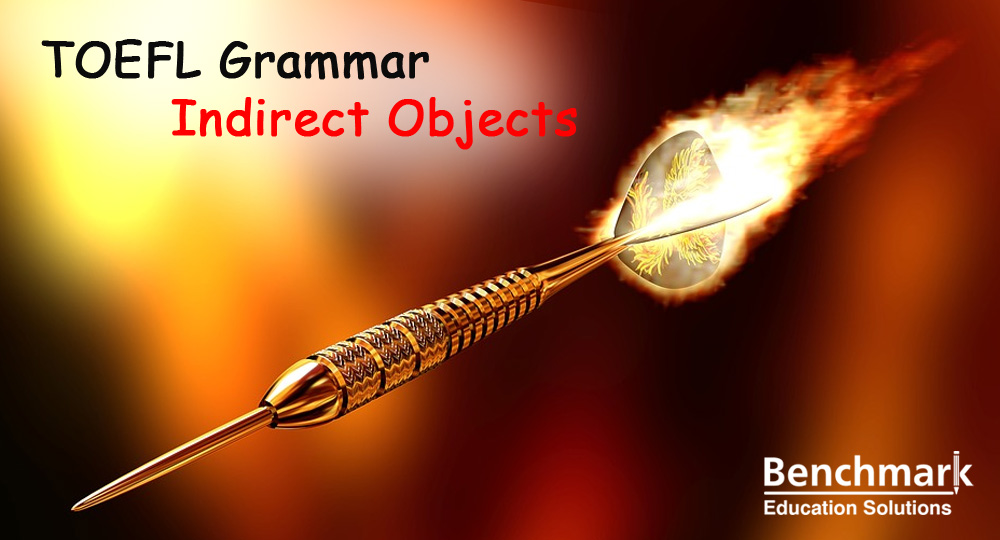Why are Indirect Objects so important in TOEFL Writing?


In the previous article, I explained what direct objects are and why they are important for TOEFL candidates. To briefly summarize that, an object is one of the most common parts of an English language sentence and it is therefore imperative that any prospective TOEFL taker should know how to use them.
I mentioned in my article that there are two kinds of object: direct and indirect. I showed you how to use direct objects first as these are the most common and most basic ones. They simply receive the action that the subject does in the clause or sentence.
In this lesson, you are going to learn what an indirect object is and how to use it so that you can give yourself a better chance of TOEFL success.
What is an Indirect Object?
In order to understand what an indirect object is, you need to first know what a direct object is, so make sure to go back and read the direct object article before proceeding.
An indirect object will basically give more information about the direct object, so they function together within a sentence. To some extent, they identify the person for whom the verb was done.
To understand this better, let’s look at an example that comes from a TOEFL essay about retirement. Try to figure out the subject, verb, and direct object. Note that there is not yet an indirect object. That will come later.
- The government pays pensions.
If you read the previous article, this was probably easy:
- Subject: the government
- Verb: pays
- Direct object: pensions
To be honest, that is not a great sentence because it is very short and contains relatively little information. To put it into a TOEFL essay would be a bad idea, so we should try to expand it a little to make it more worthwhile. I am going to add an indirect object. See if you can find it:
- The government pays retired people pensions.
What’s the indirect object? Here, it is “retired people.” In this case, the indirect object tells us who received the pensions that the government paid out.
Let’s take a look at another example:
- Some people argue that companies should provide their employees with medical insurance.
In the underlined clause, the grammar may at first appear a little confusing, but if we search for the verb, then we can analyze it more easily. The verb is “should provide” (“should” being a modal part of the verb). Who is doing the verb? “Companies” are doing it, so that is the subject. What is it that companies provide? “Medical insurance.” Therefore, “medical insurance” is the direct object. We can then tell that “their employees” must be the indirect object because it tells us for whom the direct object received the verb.
- Subject: companies
- Verb: should provide
- Direct object: medical insurance
- Indirect object: their employees
Indirect Objects and Pronouns
In the two examples above, the indirect objects were nouns but sometimes they can be pronouns. When they become pronouns, it is necessary to change the order of the sentence and put the pronoun alongside an appropriate preposition.
- After the workers demanded a high salary, the manager gave it to them.
This is a quite complicated sentence to understand, but let’s focus on the second, underlined clause. It is quite easy to identify the subject (the manager) and verb (gave), but what about the direct and indirect objects?
Well, first of all let’s think about what was given. In this case, “it” is given. Therefore, “it” is the direct object of the clause. (Remember that “it” refers to “high salary.”) When we know this, then we can see that “them” is the indirect object because it tells us for whom the verb was done. (In this case, “them” refers to “the workers.”)
In the conventional answers above, we structured the clause like this:
SUBJECT + VERB + INDIRECT OBJECT + DIRECT OBJECT
However, now we have moved the indirect object to the end of the sentence and added the preposition “to” to show the relationship more clearly. This is because the sentence would sound terrible if it followed the conventional grammar:
- After the workers demanded a high salary, the manager gave them it.
It is confusing and no one would really understand the relationship between the two objects. Now, we could try avoiding pronouns and instead use conventional nouns, but sometimes it is better to use pronouns to avoid repetition.
- After the workers demanded a high salary, the manager gave the workers a high salary.
This is grammatically acceptable, but it sounds terrible to a native speaker because of the repetition. Even if we changed one of the objects to a pronoun, it would still sound pretty bad. We really hate repetition in English!
Indirect Objects and TOEFL
Indirect objects are actually quite rare in English and so they are not a vital part of the language in terms of speaking and writing. You could probably do very well in both parts of the test without them. However, they do arise in some situations and you may find that they can help add variety and complexity to your language, so maybe they are valuable for you.
However, I do think that it is important to know them because it is quite possible they could occur in the reading or listening part of the test. If this happened, you would need to be able to determine the relationship between the different parts of the sentence in order to find a correct answer.







